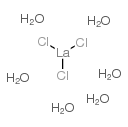氯化镧六水合物, 99.00,Lanthanum chloride, hexahydrate
产品编号:西域试剂-WR365556| CAS NO:17272-45-6| 分子式:LaCl3·6H2O| 分子量:353.36
本网站销售的所有产品仅用于工业应用或者科学研究等非医疗目的,不可用于人类或动物的临床诊断或者治疗,非药用,非食用,
| 产品名称 | 氯化镧六水合物, 99.00 |
|---|---|
| 英文名称 | Lanthanum chloride, hexahydrate |
| CAS编号 | 17272-45-6 |
| 产品熔点 | 91ºC (dec.) |
| 精确质量 | 351.87600 |
| PSA | 55.38000 |
| LogP | 1.68270 |
| 稳定性 | 能溶于水,易潮解。遇碱生成氢氧化物或氯氧化物沉淀。 |
| 储存条件 | 应贮存在通风、干燥的库房中。本品易吸水潮解,贮运中应防止包装破损,保持干燥。 |
相关文档
化学品安全说明书(MSDS)
下载MSDS质检证书(COA)
相关产品
| 海关编码 | 2915900090 |
|---|
|
Section 1: Product Identification Chemical Name:Lanthanum (III) chloride hexahydrate (99.9%-La) (REO) CAS Registry Number:17272-45-6 Formula:LaCl3.6H2O EINECS Number:none Chemical Family:metal halide Synonym:Lanthanum trichloride hexahydrate
Section 2: Composition and Information on Ingredients IngredientCAS NumberPercentACGIH (TWA)OSHA (PEL) Title compound17272-45-6100%no datano data Section 3: Hazards Identification Emergency Overview:Irritating to skin, eyes and respiratory tract. Primary Routes of Exposure:Ingestion, inhalation Eye Contact:Causes mild to severe irritation to the eyes. Skin Contact:Causes slight to mild irritation of the skin. Inhalation:Irritating to the nose, mucous membranes and respiratory tract. Ingestion:No information is available on the physiological effects of ingestion. Acute Health Affects:Irritating to skin, eyes and respiratory tract. Chronic Health Affects:No information available on long-term chronic effects. NTP:No IARC:No OSHA:No SECTION 4: First Aid Measures Immediately flush the eyes with copious amounts of water for at least 10-15 minutes. A victim may need Eye Exposure: assistance in keeping their eye lids open. Get immediate medical attention. Wash the affected area with water. Remove contaminated clothes if necessary. Seek medical assistance if Skin Exposure: irritation persists. Remove the victim to fresh air. Closely monitor the victim for signs of respiratory problems, such as difficulty Inhalation: in breathing, coughing, wheezing, or pain. In such cases seek immediate medical assistance. Seek medical attention immediately. Keep the victim calm. Give the victim water (only if conscious). Induce Ingestion: vomiting only if directed by medical personnel. SECTION 5: Fire Fighting Measures Flash Point:none Autoignition Temperature:none Explosion Limits:none Extinguishing Medium:none required If involved in a fire, fire fighters should be equipped with a NIOSH approved positive pressure self-contained Special Fire Fighting Procedures: breathing apparatus and full protective clothing. Hazardous Combustion andIf involved in a fire this material may emit toxic chlorine and hydrochloric acid fumes. Decomposion Products: Unusual Fire or Explosion Hazards: No unusual fire or explosion hazards. SECTION 6: Accidental Release Measures Spill and Leak Procedures:Small spills can be mixed with vermiculite or sodium carbonate and swept up. SECTION 7: Handling and Storage Handling and Storage:Store material in a tightly sealed bottle and keep away from heat. SECTION 8: Exposure Controls and Personal Protection Eye Protection:Always wear approved safety glasses when handling a chemical substance in the laboratory. Skin Protection:Wear protective clothing and gloves. Ventilation:If possible, handle the material in an efficient fume hood. If ventilation is not available, a respirator should be worn. The use of respirators requires a Respiratory Respirator: Protection Program to be in compliance with 29 CFR 1910.134. Ventilation:If possible, handle the material in an efficient fume hood. Additional Protection:No additional protection required. SECTION 9: Physical and Chemical Properties Color and Form:white crystal Molecular Weight:353.36 Melting Point:91° dec. Boiling Point:decomposes Vapor Pressure:not applicable Specific Gravity:no data Odor:none Solubility in Water:soluble in water SECTION 10: Stability and Reactivity Stability:air and moisture stable Hazardous Polymerization:none Conditions to Avoid:none Incompatibility:active metals such as sodium or potassium Decomposition Products:hydrogen chloride SECTION 11: Toxicological Information For lanthanum chloride (anhydrous): Oral (rat); LD50: 4184mg/kg. Interperitoneal (rat); LD50: 106mg/kg. Intravenous (rat); LDLo: 4mg/kg. Intraperitoneal (mouse); LD50: 121mg/kg. Subcutaneous (mouse); LD50: 2424mg/kg. Intravenous (mouse); LD50: 18mg/kg. Intravenous (rabbit); LD50: 148mg/kg. Intraperitoneal RTECS Data:(guinea pig); LD50: 129mg/kg. Intraperitoneal (frog); LD50: 694mg/kg. Intraperitoneal (mouse); TDLo: 112mg/kg. Intratesticular (domestic mammal); TDLo: 5mg/kg. Morphological transformation (mouse cells); 30 umol/L. Sperm Morphology (Intratesticular - domestic mammal); 5mg/kg. Effects include somnolence and general depression. Carcinogenic Effects:No data available Mutagenic Effects:No data available Tetratogenic Effects:No data available SECTION 12: Ecological Information Ecological Information:No information available SECTION 13: Disposal Considerations Disposal:Dispose of according to local, state and federal regulations. SECTION 14: Transportation Shipping Name (CFR):Non-hazardous Hazard Class (CFR):NA Additional Hazard Class (CFR):NA Packaging Group (CFR):NA UN ID Number (CFR):NA Shipping Name (IATA):Non-hazardous Hazard Class (IATA):NA Additional Hazard Class (IATA):NA Packaging Group (IATA):NA UN ID Number (IATA):NA SECTION 15: Regulatory Information TSCA:listed in the TSCA inventory as LaCl3 (CAS# 10099-58-8) SARA (Title 313):not regulated by Title 313 Second Ingredient:none SECTION 16 - ADDITIONAL INFORMATION N/A |









 浙公网安备 33010802013016号
浙公网安备 33010802013016号